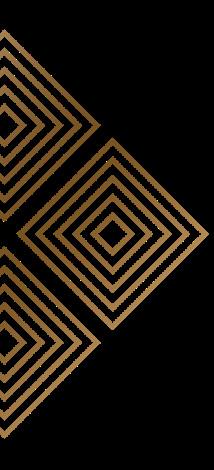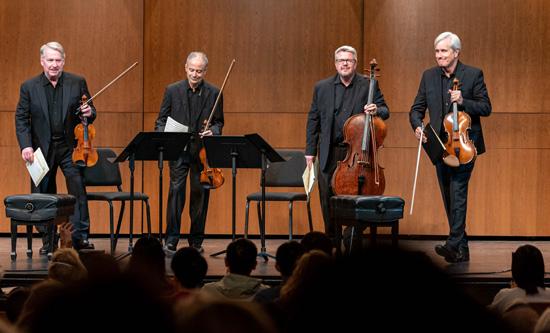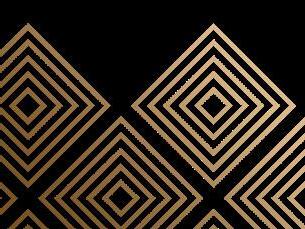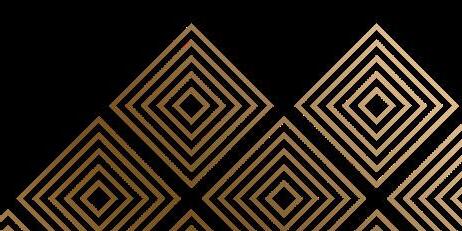DANISH STRING QUARTET

TUESDAY, APRIL 18, 2023 | 7:30 PM

SHANNON HALL AT MEMORIAL UNION

IN-PERSON
WISCONSIN UNION THEATER
& VIRTUAL
SUPPORT FOR THE 2022–2023 CONCERT SERIES PROVIDED IN PART BY:
Christine Beatty
Sam Coe
Charles Cohen
Dr. Linda I. Garrity Living Legends Endowment Fund
Michael Hoon
Penny Hubbard
Bill and Char Johnson Classical Music Series Fund
Charles Leadholm
Terry Moen
Stephen Morton
David and Kato Perlman Chamber Music Fund
Fan Taylor Fund
Douglas and Elisabeth B. Weaver Fund for Performing Arts
Mead Witter School of Music
Wisconsin Union Theater Endowment
PROGRAMMED BY THE PERFORMING ARTS COMMITTEE
The Wisconsin Union Directorate Performing Arts Committee (WUD PAC) is a student-run organization that brings world-class artists to campus by programming the Wisconsin Union Theater’s annual season of events. WUD PAC focuses on pushing range and diversity in its programming while connecting to students and the broader Madison community.
In addition to planning the Wisconsin Union Theater’s season, WUD PAC programs and produces student-centered events that take place in the Wisconsin Union Theater’s Play Circle. WUD PAC makes it a priority to connect students to performing artists through educational engagement activities and more.
WUD PAC is part of the Wisconsin Union Directorate which is housed in the Social Education unit at the Wisconsin Union. It is central to the Wisconsin Union's purpose of developing the leaders of tomorrow and creating community in a place where all belong.
2
DANISH STRING QUARTET
TUESDAY, APRIL 18, 2023
FRANZ SCHUBERT (1797-1828)
JOSEPH HAYDN (1732–1809)
String Quartet No. 12 In C Minor, D. 703, "Quartettsatz" (1820)
String Quartet in G Minor, Op. 20, No. 3 (1772)
Allegro con spirito
Minuet: Allegretto—Trio
Poco adagio
Allegro molto
DMITRI SHOSTAKOVICH (1906–1975)
String Quartet No. 7 in F-sharp Minor, Op. 108 (1960)
Allegretto—
Lento—
Allegro—Allegretto
BENJAMIN BRITTEN (1913–1976)
Three Divertimenti (1936)
March
Waltz
Burlesque
INTERMISSION
TRADITIONAL
Folk Music (arr. Danish String Quartet)
To be announced from the stage
3
JOSEPH HAYDN (1732–1809)
String Quartet in G Minor, Op. 20, No. 3 (1772)
The six quartets (called “divertimentos” when published in 1774) of Op. 20 mark a turning point in Haydn’s approach to the genre, treating the string quartet as a significant medium for his artistic prowess. The collection establishes the four-movement standard for string quartets, as well as the role of fast tempos for outer movements. They are unique in that the dance movement (Minuet) comes before the slow movement. In No. 3 specifically, the slow movement features a complete sonata form, unlike later slow movements that tend to omit the development section. They also display increasing independence for each instrument, presenting them as, at least, capable of performing as the soloist, even if the first violin remains dominant.
Formal aspects aside, Op. 20 and especially No. 3 in G Minor exemplify the so-called Sturm und Drang (“storm and stress”) style of the 1760s and 1770s. While the validity of this term has been debated—it is the title of a play from 1776, after the musical style had peaked—the phenomenon of composers writing moody works in minor keys was widespread. For Haydn, these works illustrate the duality of his personality, embodying both subjective emotional honesty and objective witty charm. His reputation as a humorous composer is, of course, well founded, but it is based largely on his later works that were written for a public audience. Upbeat optimism tends to go over better with the masses, and so Haydn honed a public musical persona to match. Yet in the 1770s he was not yet a “free” musician, but rather a court composer employed by Prince Esterházy. Although in this role he was composing at the behest of one man, he was afforded a different kind of artistic freedom that allowed him to express darker feelings and create music that aimed to be, in his view, sublime.
In the opening Allegro con spirito, Haydn begins an elegant sonata allegro movement that has an understated confidence. As it progresses to the second theme, Haydn maximizes the chromatic harmonies available in the minor key for a darker and moodier effect. The second movement, Minuet, takes this minor mode further with a moderate tempo and leaping melody that longs for tonal resolution. Haydn provides that resolution in the rolling and rustic E-flat–major Trio section. With the return to the opening, the movement concludes quietly and unresolved, which in a different context (or simply in a major key) would feel humorous and ironic, but here comes across as unsettled. The slow third movement features lush harmonies and uniform counterpoint recalling a Bach chorale for the first theme, followed by each instrument taking turns in flowing scalar passages for the second. The textural contrast from unity to independence further throws into relief Haydn’s use of the cello as a melodic solo instrument. The final movement’s spritely character skews toward Haydn’s charming and witty side; yet the G-minor tonality and aggressive half-step trill motive showcase the more complex harmonic language of the Sturm und Drang style.
DMITRI SHOSTAKOVICH (1906–1975)
String Quartet No. 7 in F-sharp Minor, Op. 108 (1960)
Composed in 1960, Shostakovich’s Seventh String Quartet premiered mere months before his more famous Eighth. At the height of Khrushchev’s Thaw in the USSR—when the leader secretly denounced Stalin’s crimes while still trying to maintain central authority—Shostakovich found himself professionally reconciling with officials, even joining the Communist Party and performing an array of bureaucratic duties in the Composers Union (potentially in a tit-for-tat relationship, as his previously banned works were getting new performances). All the while, in his personal life, he had reached an all-time low. His second marriage ended in divorce in less than four years. His official acquiescence to authorities and politics belied his deeper frustrations with the state of the world, leading not to political dissidence—as the largely spurious interpretations of the Eighth String
4
Quartet have long suggested—but rather to disillusionment and disenfranchisement. Dedicating the Seventh String Quartet to the memory of his first wife, who had died four years earlier, the past is very much present and right under the surface in this piece.
The quartet is divvied up in the score into three movements performed without pause. Yet over the course of the approximately 12-minute work, Shostakovich uses a sparse number of motives returning in an array of diverse meters and changing accompaniment styles, such that the overall continuity of the work stands out. He even dovetails the second and third movements by foreshadowing a major motive of the latter at the end of the former, thus letting past and present, memory and moment mix freely. The cyclical motivic callbacks of the final movement trigger feelings of unfinished memories more than closure. The opening Allegretto lays out much of the motivic material, including the pounding three-beat repetition and the cello melody of the driving second theme, which hints at the plaintive tunes of the yet-to-be-heard Lento movement. Throughout the work, Shostakovich maintains his characteristically sardonic style: The light melodies are sarcastic, the impassioned ones, anxious. The rare optimistic melodies sound like quotations from his earlier vocal works, but remain situated in a depressing new context. Imbuing his work with the heavy weight of memory, nostalgia, and regret, Shostakovich managed to let his deeply personal depression mirror the larger questions of past and present that his country was also facing.
BENJAMIN BRITTEN (1913–1976)
Three Divertimenti (1936)
Completed and premiered at Wigmore Hall in 1936 to “sniggers and cold silence” (as the composer noted in his journal), Britten’s Three Divertimenti for String Quartet formed an early mature work that he immediately withdrew from the public. It was published posthumously in 1983. The Times review from the following day likely sealed the work’s fate; the critic described it as “much play with technical devices, but little solid matter to justify the escapades. Mr. Britten will have proved his worth as a composer when he succeeds in writing music that relies less on superficial effect.” Yet to listen to the Three Divertimenti today, 90 years after their original composition and armed with the knowledge of Britten’s undeniably and unabashedly tonal language and the irrepressible Romanticism of his style, it throws into relief how much perceptions of “normal” and “experimental,” as well as “style” and “substance,” change over time. Indeed, the three character pieces—which purportedly portrayed some of his school friends—each foreground Britten’s gift for tuneful melodies that convey emotion and personality while nonetheless evoking mood and atmosphere.
The opening bars of the March set out heightened ambiguity with sparse percussive motives and long sliding glissandos—yet this quickly gives way to tuneful and propulsive exchanges between the instruments that feel entirely vital and, at times, rustic, with mild dissonances that are rich and resonant rather than clamorous. The Waltz—perhaps the only true “diversion” of the work—masterfully balances the easy, constant swaying of the dance form with the impulse to follow fun dalliances for their own sake. (And this waltz, by the way, hardly compares for unsettling atmosphere or “superficial effects” to Ravel’s La valse, composed more than a decade earlier.) In the final Burlesque, an anxious frenzy drives upward in search of resolution and relief, but it finds no real calm. Instead, the work builds in repeating waves that ultimately dissipate in moments of passionate melodic clarity only to build back up again. In the end, Britten’s compositional voice is fully formed in this work that he kept from the public. While the initial audience and first critic heard all style without substance, today the Divertimenti resound with an assertive balance of emotional earnestness and compelling atmosphere that would come to characterize the composer’s unique style.
5
TRADITIONAL
Folk Music (arr. Danish String Quartet)
For the second half of this evening’s performance, the Danish String Quartet performs a variety of folk music that the musicians have arranged themselves. On the face of it, folk music is in many ways self-explanatory: It is music played and sung by the folk. But exactly who the folk are and their musical traditions are, in fact, quite obscure. Folk music, as a genre, carries larger cultural import than any simple definition could suggest. The idea of folk music as we know it today comes from German theologian Johann Gottfried von Herder, who argued in the 1790s that the “soul of a nation” could be found in its folk songs. He understood that the music of the peasantry was deeply connected to a shared sense of cultural (or ethnic) identity. For the Danish String Quartet, “folk music is the music of all the small places. It is the local music, but as such it is also the music of everywhere and everyone.”
The 1800s saw the beginning of organized initiatives to collect folk music across Europe. In Denmark, these projects took place in 1809–1814 and again in 1840–1877; the publications that resulted make up the backbone of Danish folk music. The music collected was that of people who shared their music orally (and aurally) in their communities. The first public schools in Denmark were not founded until 1894. (For comparison, though it varies by state, elementary education was not made a national requirement in the US until 1918). Without the ability to read and write as taught in schools, folk-song collectors did not encounter written music.
While these 19th-century folk-music collections are a major resource for Danish folk music, older sources closely associated with local and regional identities also have inspired the Danish String Quartet. The group has drawn melodies like “Drømte mig en drøm” (“I Had a Dream”) from the Codex Runicus (ca. 1350), “Den yndigste Rose er funden” (“Now Found Is the Fairest of Roses”) from Lutheran hymns from the 1700s, and Old Norse melodies sung in Viking outposts in modernday Scotland, such as “Unst Boat Song.” Although vocal melodies make up a large portion of folk music, instrumental music—almost all in various dance forms, including polkas, waltzes, minuets, reels, and quadrilles—was also preserved through oral traditions. The names of the original composer-performers of folk music are by and large unknown today because they did not have status, money, or the ability to assert their authorship by writing down their work. Yet their music inspired so many to continue to perform it that it became a fundamental part of a community’s shared experience and identity. As the Danish String Quartet explains, “In these old melodies, we find immense beauty and depth, and we can’t help but sing them through the medium of our string quartet.”
—Eric Lubarsky
6
DANISH STRING QUARTET
The Danish String Quartet celebrates its 20th anniversary in 2022–2023, and the Grammynominated ensemble continues to assert its preeminence among the world’s finest string quartets. Formed when they were in their teens, the quartet musicians are renowned for their impeccable musicianship, sophisticated artistry, exquisite clarity of ensemble, and, above all, and an unmatched ability to play as one. Performances are characterized by a rare musical spontaneity, giving audiences the sense of hearing even treasured canon repertoire as if for the first time. They exude a palpable joy in music-making that has made them one of today’s most highly acclaimed and indemand classical quartets, performing to sold-out concert halls around the world. Their inventive and intriguing programming and repertoire choices have produced critically acclaimed original projects and commissions as well as popular arrangements of Scandinavian folk music.
The Danish String Quartet performs 28 concerts in North America this season over the course of three separate tours, and serves as artist-in-residence at London’s Wigmore Hall. Among other projects, the quartet continues its ambitious Doppelgänger series, a four-year international commissioning project that pairs world premieres from four renowned composers—Bent Sørensen, Lotta Wennäkoski, Anna Thorvaldsdóttir, and Thomas Adès—with late major chamber works by Schubert. The project will culminate in 2024 with the premiere of a quintet by Adès after Schubert’s String Quintet in C Major. This season’s commission by Thorvaldsdóttir premieres in April 2023 with Schubert’s String Quartet in A Minor, "Rosamunde." The Doppelgänger works are commissioned by the Danish String Quartet with the support of Carnegie Hall, Cal Performances, UC Santa Barbara Arts & Lectures, Vancouver Recital Society, Brussels’s Flagey, and Amsterdam’s Muziekgebouw.
The quartet’s most recent recording project is Prism, a series of five discs on ECM New Series that explores the symbiotic musical and contextual relationships between Bach’s fugues, Beethoven’s string quartets, and works by Shostakovich, Schnittke, Bartók, Mendelssohn, and Webern. Four of the five recordings have been released on ECM, and the fifth is slated for 2023. The most recently released is Prism IV (2022), which was an “Editor’s Choice” in Limelight magazine. The quartet’s discography reflects the ensemble’s special affinity for Scandinavian composers with the complete quartets of Carl Nielsen (Dacapo, 2007 and 2008) and Adès, Nørgård, and Abrahamsen (ECM debut, 2016). They also released two discs of traditional Scandinavian folk music, Wood Works (Dacapo, 2014) and Last Leaf (ECM, 2017), which was one of the top classical albums of the year as chosen by NPR, Spotify, and The New York Times, among others. A third folk recording is planned for release in 2023 on ECM.
In 2007, the quartet established the DSQ Festival, which takes place in intimate and informal settings in Copenhagen. In 2016, they inaugurated a concert series, Series of Four, in which they both perform and invite colleagues to appear. They are the recipients of many awards and prestigious appointments, including Musical America’s 2020 Ensemble of the Year and the Borletti-Buitoni Trust Award. In 2013, the quartet was named a BBC Radio 3 New Generation Artists and appointed to The Bowers Program (formerly CMS Two). They were awarded the 2010 NORDMETALL-Ensemble Prize at the Mecklenburg-Vorpommern Festival in Germany, and in 2011, they received the Carl Nielsen Prize, Denmark’s highest cultural honor.
Violinists Frederik Øland and Rune Tonsgaard Sørensen and violist Asbjørn Nørgaard met as children at a music summer camp where they played soccer and made music together. As teenagers, they began the study of classical chamber music and were mentored by Tim Frederiksen of Copenhagen’s Royal Danish Academy of Music. In 2008, the three Danes were joined by Norwegian cellist Fredrik Schøyen Sjölin.
Exclusive Representation: Kirshbaum Associates Inc.
307 Seventh Avenue, Suite 506
New York, NY 10001
kirshbaumassociates.com
The Danish String Quartet is currently exclusive with ECM Records and has previously recorded for Dacapo and CAvi-Music/BR-Klassik.
7
THANK YOU TO OUR GENEROUS DONORS FOR SUPPORTING THE WISCONSIN UNION THEATER
Association of Performing Arts Professionals
Mohamed F. Bacchus
John A. Barnhardt
Gretchen E. Baudenbacher
Christine Beatty
Steven L. Behar & Donnette Behar
Robert M. Bell & Jeanne L. Bell
Tracy L. Benton
James H. Bigwood & Jay Cha
Miriam S. Boegel & Brian M. Boegel
Christine W. Bohlman & Philip V. Bohlman
Brittingham Wisconsin Trust
Michael T. Brody & Elizabeth K. Ester
Courtney A. Byelich & David M. Cober
Patrick J. Callan
Glenna M. Carter
Lisa M. Cichy & Stephen J. Cichy
Peter C. Christianson
Matthew S. Clark
Sam Coe
Charles L. Cohen & Christine A. Schindler
Howard M. Collens
Theodore E. Crabb & Barbara B. Crabb
David R. Cross
Eric W. Curtis
George C. Cutlip
Dane Arts
Joseph P. Davis III & Wendy T. Davis
Kelly G. DeHaven
Stephanie M. Díaz de León
Leslie D. Dinauer & Stephen R. Dinauer
Kelly G. DeHaven & David T. Cooper
Sean P. DeKok
Darren M. DeMatoff
Lori A. DeMeuse
André De Shields
Mark A. Dettmann
Bess Donoghue
Elizabeth G. Douma
Sophia E. Dramm
Curtis J. Edmonds
Rae L. Erdahl
John R. Evans
Evjue Foundation Inc.
Jon E. Fadness
Carol H. Falk & Alan F. Johnson
Hildy B. Feen
Fidelity Charitable
Isabel K. Finn
Janice R. Fountain
Tara L. Genske
Leonard H. Gicas
Clarke C. Greene
Mary Greer-Kramer
Geraldine K. Gurman
Mark C. Guthier & Amy Guthier
Robert J. Hanson & Kayla Hanson
Jennifer C. Hartwig
Robert T. Harty & Mona-Lee Harty
Marlene T. Hartzman
Justin D. Hein & Paige A. Hein
Brent T. Helt
Michael Hoon
Michael E. Hosig
Penny M. Hubbard
Wesley Hyatt
Wichnart A. Imsangjan
Arnold R. Isaacs & Kathleen T. Isaacs
Arnold F. Jacobxon
Prashanth Jayachandran & Neena M. Patil
Brian M. Jenks
Hannah Y. Jurowicz
Kristen E. Kadner & Brian J. Roddy
Kelly R. Kahl
Edward F. Kakas III & Andrea J. Lund-Kakas
William E. Kasdorf
Evelyn L. Keaton
Daniel J. Koehn & Mark R. Koehn
Diane M. Kostecke & Nancy A. Ciezki
Mary G. Kramer
Christian J. Krautkramer & Alli Grady
8
Carolyn J. Kruse & Ellen M. Pryor
Matthew A. Lamke
Charles R. Leadholm, MD & Jeanne M. Parus
Caryn E. Lesser
Shana R. Lewis & Robert D. Magasano
Nicole R. Lucas
Douglas P. Mackaman
Roberta L. Markovina
Jeanne A. Marshall
Jeffrey Mattox & Helen Mattox
Anita L. Mauro & Daniel Mauro
Carol J. May
Charles F. Merbs
Terry Moen
Stephen Morton
Shibani C. Munshi, MD
Christopher Murphy & Gloria Mojarro
Eric E. Nathan
Christian E. Neuhaus
Victoria K. Palmer-Erbs
Stephen E. Parker
Ann K. Pehle
Kato L. Perlman
Elizabeth L. Preston & Burton R. Preston
Reinhart Boerner Van Deuren SC
Mark J. Reischel, MD & Angela Reischel
Jeremy V. Richards
Faye K. Robinson
Michelle L. Rogers
Emily A. Ronning
Ian M. Rosenberg
Kristi A. Ross-Clausen
Sharon S. Rouse
Erik C. Rudeen
Douglas K. Rush
Ralph F. Russo & Lauren G. Cnare
Vinod K. Sahney & J. Gail Meyst Sahney
Emil R. Sanchez & Eloisa R. Sanchez
Elizabeth B. Schaffer & Steven C. Schaffer
John W. Schaffer & Sarah L. Schaffer
Lucas L. Schneider
Carol L. Schroeder & Dean H. Schroeder
Donald A. Schutt Jr. & Sarah L. Schutt
Ruth Shneider Brown
Margaret A. Shukur & Robert Ruxin
Judith N. Sidran & Ben H. Sidran
Charles E. Simon
Small Business Administration
Thomas R. Smith
Elizabeth Snodgrass & Jonathan Stenger
Polly Snodgrass
Kristina Stadler
Marcia J. Standiford & Kenneth P. Ferencek
Frank Staszak
Lynn M. Stathas
Diane L. Steele
James D. Steinberg
Jason L. Stephens & Ana C. Stephens
Ann M. Sticha
T. Rowe Price Charitable Giving
Nancy A. Theisen
Tiffany A. Thom Kenney & Vincent J. Kenney
Thompson Investment Management
Michele Traband & Thomas O. Traband
Teresa H. Venker
Joshua H. Wallach
Ronald M. Wanek & Janet E. Wanek
Kathleen A. Williams
Lisa D. Winkler & Dirk A. Korth
Wisconsin Arts Board
Janell M. Wise
James H. Wockenfuss
Betsy A. Wood & Thomas Coyne
Sarah Wood & David Anderson
McKenzie E. Zdrale & Zachary Zdrale
Katelyn R. Zutter
9
THANK YOU FOR THE GREAT SEASON!





 MANHATTAN CHAMBER PLAYERS September 29, 2022
EMERSON STRING QUARTET September 24, 2022
MANHATTAN CHAMBER PLAYERS September 29, 2022
EMERSON STRING QUARTET September 24, 2022
10
GENEVA LEWIS WITH EVREN OZEL January 27, 2023 SŌ PERCUSSION WITH CAROLINE SHAW November 5, 2022
THE 2023–2024 SEASON IS COMING SOON!



To stay updated on the latest at the Wisconsin Union Theater, join our email list:




11
WISCONSIN UNION THEATER
Elizabeth Snodgrass, Director
Isabel Celata, Administrative Assistant
Kate Schwartz, Artist Services Manager
Kendra Ramthun, General Manager
Jeff Macheel, Technical Director
Heather Macheel, Technical Director
Epiphany Holmstock, Financial Assistant
Steve Dong, General Management Assistant
M. Murphy, Operations & Events Intern
Chloe Tatro, Lead House Manager
Christina Majchrzak, Director of Ticketing
Sean Danner, Box Office Manager
Will Griffin, Ticketing and Web Systems Administrator
Allie Boeckmann, Box Office Supervisor
Jos Comiskey, Box Office Supervisor
WISCONSIN UNION DIRECTORATE PERFORMING ARTS COMMITTEE
Dawry Ruiz, Director
Abbey Perkins, General Programming Associate Director
Azura Mizani Tyabji, General Programming Associate Director
Henry Ptacek, General Programming Associate Director
Diya Abbas, Committee Management Associate Director
Lindsey Mathews, Marketing Associate Director
Wisconsin Union Theater
800 Langdon St., Madison, WI 53706
Main Office: 608-262-2202
Box Office: 608-265-ARTS
uniontheater.wisc.edu
/WisconsinUnionTheater
@wiuniontheater
@wisconsinuniontheater









 MANHATTAN CHAMBER PLAYERS September 29, 2022
EMERSON STRING QUARTET September 24, 2022
MANHATTAN CHAMBER PLAYERS September 29, 2022
EMERSON STRING QUARTET September 24, 2022






